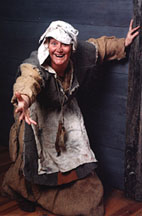Meet the Middle Ages
BackThe Citizens of Kalmar Town

Almost half the population were merchants or craftsmen and their families. The others were servants, house-keepers, apprentices or assistants. There were 50 or so priests, monks and nuns as well. A number of persons were employed by the Town Council; scribes as well as inspectors and controllers of goods. On feast days or on the weekly market-days, beggars would come to town as well.
During the 13th and 14th centuries, many of the inhabitants of Kalmar came from the north German regions of Pommern, Mecklenburg, Holstein and Preussen. They spoke Low German. The longer they stayed in the town, the more at home they felt.
We know a lot about the people who lived in Kalmar. The people who ruled the town, the members of the Town Council, took notes and all matters decided upon were written down in a large book. This book or annual - "Tänkeboken" – tells us of when a new family came to town and were they lived. Sometimes one can gather how these people were or what they looked like. In the "Tänkebok" notes has been taken down on how a will was acted upon and on who had made donations to the church. "Tänkebok" means thought-book or "memory-book". It was important to remember what had been decided. At the end of the 14th century the "Tänkebok" was written mainly in German, but during the 15th century, the notes were mainly written in Swedish.
In the summer of 1997, Swedish Television (SVT) broadcast a summer holiday serial called "Salve". There one could meet some of the people who lived in Kalmar in 1397. Nils from the 20th century met Christina the bread-seller, Aslo the strap-maker, Rodwy the blood-letter and many others from medieval Kalmar.
You can get acquainted with the citizens of Kalmar as well! The map shows you were they lived.